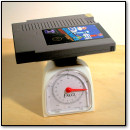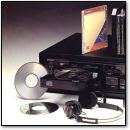Archive for the 'Vintage Computing' Category
[ Retro Scan of the Week ] Internet in a Box
Monday, January 20th, 2014[ Retro Scan of the Week ] Low-End Virtual Reality
Tuesday, January 7th, 2014 Every new idea is an old idea with more transistors.
Every new idea is an old idea with more transistors.
A few years ago, a relative gave me a couple issues of PCVR Magazine, a low-circulation 1990s periodical dedicated to virtual reality. Here’s the cover of the Jan/Feb 1994 issue, which features an illustration of the magazine’s build-it-yourself head tracker project.
In the early 1990s, the “virtual reality” concept hit a peak in the popular media that coincided with dozens of companies pursuing motion-tracking head-mounted displays — both with honest attempts and blatant gimmicks.
If I had to guess why VR exploded in the popular tech consciousness at that particular time, I would trace it it to the emergence of small, relatively low-cost color LCDs — the kind that made portable consoles like the Atari Lynx and Sega Game Gear possible. Compared to bulky, power-hungry CRT displays, the (relatively) thin, low-power LCDs could be worn on the head with mobility and without too much discomfort. That prompted a minor Cambrian explosion of VR headset hardware.
But the display technology just wasn’t there yet. Affordable LCDs were very low resolution (think 320×200 or less), and higher-resolution LCDs cost thousands of dollars a piece.
In addition, the hardware and software required to generate convincing virtual reality experiences were neither affordable nor generally available. So genuinely immersive VR found itself stuck in corporate and university research labs; meanwhile, the public got trickle-down fad headsets like the Stuntmaster.
Today, we find ourselves in the middle of a VR renaissance thanks to Oculus Rift. But this time, we may actually be at the edge of mainstream virtual reality headsets because the technology has come quite a long way since 1994. I look forward to meeting your 3D virtual avatar in cyberspace soon.
Discussion Topic of the Week: Have you ever used a virtual reality headset of any kind? Tell us about it.
—
See Also: Retro Scan of the Week Special Edition: “At Last! Reality For the Masses!” (VC&G, 2007)
See Also: The History of Stereoscopic 3D Gaming (PC World, 2011)
[ Retro Scan of the Week ] Printer Paper Christmas
Monday, December 23rd, 2013[ Retro Scan of the Week ] Benj’s 1989 Christmas List
Monday, December 16th, 2013 An early example of the rustic illustrated Christmas list
An early example of the rustic illustrated Christmas list
While sorting through my childhood papers and effects recently, I came across this amusing Christmas list from 1989. I was eight years old then, and I apparently ripped out pictures of the toys I wanted from weekly newspaper advertisements and pasted them on a sheet of 8.5″x 11″ wide-ruled notebook paper. The result was a rare illustrated Christmas list that I don’t remember making before or since.
(I’m not sure why there is a big chunk of the page missing in the upper-right corner, by the way. Perhaps I changed my mind on some item and physically removed it from my list.)
What’s notable for our purposes is the healthy contingent of video game related items on the list. There’s a wireless remote for the NES, a Game Boy (which had just been released that year), and even a Sega Master System.
[ Continue reading [ Retro Scan of the Week ] Benj’s 1989 Christmas List » ]
The VC&G Christmas Collection (2013 Edition)
Friday, December 13th, 2013
It’s that time of year again: the Yuletide. In celebration, I thought I’d search through the VC&G archives for Christmas material and collect it all in one place. (I also did this the last few years, but I have updated the list of links with new material for 2013.)
Below you will find a list of everything Yule-flavored from this site and my offsite freelance work. There are a couple slideshow gems in there that you don’t want to miss, so check those out if you haven’t already.
I have a soft spot for Christmas, having been raised with the tradition, so this list is for me as much as it is for everyone else. After going through these things again, it’s amazing to see how much Christmas stuff I’ve posted over the years. I hope you enjoy it.
[ Continue reading The VC&G Christmas Collection (2013 Edition) » ]
[ Retro Scan of the Week ] Doom is 20
Monday, December 9th, 2013 One of the best reasons to own a Jaguar circa 1994
One of the best reasons to own a Jaguar circa 1994
Twenty years ago this week, id Software launched one of the most important and influential PC games of all time: Doom. It started as a modest shareware download but grew to change the entire video game industry. To explain how, here’s 2009 Benj writing about the title for a PC World slideshow:
Id’s archetypical first-person shooter triggered a sea change in the PC game industry, which had formerly been dominated by slow, plodding strategy turn fests, brainy simulations, and stilted PC action titles of yore.
In contrast, Doom was the first of a new generation of fast-paced, smooth action titles that utilized new visual techniques to push PC hardware to its limits. With Doom, PC gamers could experience fluid gameplay, graphics, and sound that easily topped what was found on home game consoles of the day — an uncommon achievement at that point.
Moreover, it introduced exciting new network multiplayer options that are widely imitated to this day, coining the term “deathmatch” in the process.
From its lowly roots as a MS-DOS shareware title, Doom spread like a weed to other platforms, including game consoles, which now count first-person shooters as one of their best-selling genres.
“Doom defined the 3D shooter genre and made multiplayer gaming mainstream,” says Tim Sweeney (founder of Epic Games and creator of the Unreal Engine), “And it did them with such incredible polish, artistry, and foresight that it created an industry.”
Considering that Doom launched in 1993 via shareware channels, I’m not aware of when or in what publication the first advertisement for Doom appeared. (I believe GT Interactive became distributor for the full, boxed PC version of Doom much later, but I could be mistaken.)
So instead, I found this nifty November 1994 scan for the Atari Jaguar version of Doom. I received this version of the game for Christmas in 1994, and it was an amazing gift.
Pushing the PC Limits, Jaguar Relief
Most people don’t remember how much horsepower Doom required in a PC at the time — at least 4 MB of RAM, a mid-range 486 CPU, and a sound card to run passably well. So I had trouble running the game on any PC up to that point.
In 1993, we had one 486 in the household with exactly 4 MB of RAM (to contrast, my personal PC sported a 16 MHz 386 and 2MB RAM), and I had to make a special 5.25″ boot disk that loaded fewer resident DOS drivers, etc. so I could run Doom on that 486 at all. If I recall correctly, I didn’t have enough spare RAM to load the SoundBlaster drivers at boot, so the experience was limited. My friend had to run Doom on his mom’s 486 the same way. Even then, the game didn’t run at full frame rate. Doom pushed the limits.
So coming from that environment, it was an amazing convenience to just plug a Doom cartridge into the Jaguar and play, full-speed, full-screen, with glorious sound and no hiccups. My brother and I played a lot of Doom on that console well into 1996 — until I got a more powerful PC that could run Doom with ease.
Until the PlayStation port of Doom came out (late 1995), the Jaguar port was widely considered the best port of the game (in terms of screen window size, lighting effects, monster interaction, sound, controls, and frame rate) available on consoles. Its biggest drawback was lack of a soundtrack during gameplay. I think that’s because John Carmack used the Jag’s DSP co-processor to handle graphics routines instead of music, which was unconventional on that platform.
But I digress. What a great game. I still play Doom regularly via modern source ports on the PC — most recently on my new 1080p big screen TV set. Add on Xbox 360 controller support via ZDoom, and you’ve got Doom heaven. It’s a game that never seems to get old for me, even 20 years on. That’s the mark of a true classic in my book.
Discussion Topic of the Week: How did you feel when you first played Doom? What are your memories of the occasion?
The VC&G Thanksgiving Collection (2013 Edition)
Tuesday, November 26th, 2013 Hello, and welcome to VC&G’s 2013 Thanksgiving Spectacular. I’m your host for this evening, Burt Edwards.
Hello, and welcome to VC&G’s 2013 Thanksgiving Spectacular. I’m your host for this evening, Burt Edwards.
Thanksgiving is a great excuse to spend time with family around a four-player game of Gauntlet IV for the Sega Genesis. Or perhaps a Super Bomberman tournament. Or eight-player networked Atari Jaguar Battlesphere? Did I mention a 16-player Mario Kart Double Dash LAN battle?
One of each, please.
But before you stuff yourself with turkey and get lost in multiplayer fragfests, feel free to enjoy the following Thanksgiving-themed posts I have culled from the annals of VC&G history.
- [ Retro Scan of the Week ] Gather ‘Round the Videotex (2013)
- [ Retro Scan of the Week ] Family Computing (2011)
- [ Retro Scan of the Week ] An Apple //c Thanksgiving (2010)
- A 1980s Home Computer Family Celebration (2009)
- [ Retro Scan of the Week ] The NES Action Set Family (2009)
- Guest Editor Introduction: ULAF EDIT THE GHOST THIS WEEKS (2007)
- What Computer Nerds Should Be Thankful For (2006)
That is all for now. Let the thankfulness begin!
Internet Archive’s Historical Software Collection is the Best Thing That Has Ever Happened to Software Preservation
Tuesday, November 26th, 2013Three cheers for Jason Scott and his push to create a JavaScript-based port of the MESS emulator platform. The result, the Internet Archive’s Historical Software Collection, is nothing short of brilliant.
The collection puts dozens of vintage computer games and applications at your fingertips by allowing you to run them, emulated, from a browser window. It’s a huge step forward for preserving the heritage of our software culture. Here, ease-of-access is key.
I’ve been horribly remiss by not mentioning this earlier — but better late than never for something this important.
[ Retro Scan of the Week ] Gather ‘Round the Videotex
Monday, November 25th, 2013 A time when TVs were made of wood and children were not yet rabid.
A time when TVs were made of wood and children were not yet rabid.
In honor of Thanksgiving, a holiday which tends to emphasize family, I’ve dug up this AT&T Sceptre Videotext Terminal box art that I captured years ago. Look at those gloriously generic 1980s folks gathered around the TV set.
(I say “captured” for this image and not “scanned” because the image is actually a photo of the side of the box — the box itself is far too large to fit on a scanner. It’s roughly 14″ tall by 18″ wide by 11″ deep, if memory serves.)
Videotex: Smart TV in 1983
It’s funny: I’ve purposely avoided talking about Videotex on this blog for eight years because I was saving up material for a story about Teletext and Videotex. I have bought maybe a dozen vintage books on the two subjects since 2006 and mined news archives for information. But as they say, the best laid plans of mice and men oft go to Disneyland. Maybe I will get around to finishing that piece some day. Probably not.
So here’s the skinny. “Videotex” is the name for a graphical computer communications standard that was designed to display mixed visual and text information on regular TV sets. The idea was that a customer would buy a terminal (such as the one seen here), subscribe to a CompuServe/Prodigy/AOL-like online service, and use the terminal to connect to the service and view the information on their home TV set. Kinda like WebTV before the Web. Heck, kinda like smart TVs before the smart.
Graphically, Videotex used the NAPLPS protocol (similar to Prodigy, which grew out of these commercial Videotex experiments) to quickly transmit graphics to the user’s terminal. NAPLPS saves bandwidth because instead of storing/sending data on every pixel (like a bitmap image), the protocol describes graphics in terms of mathematical geometrical shapes (i.e. “draw a triangle at this location and fill it with orange,” like vector graphics).
By the mid-1980s, Videotex services fizzled in the marketplace. Their failure was likely due to low utility (not very useful), plus high cost of subscription (likely from high overhead on the service’s part in both hosting and creating content), and from competition from much more versatile and easier-to-interface-with personal computers.
AT&T Sceptre Videotex Terminal
And so that brings us to this side box art for a circa-1983 AT&T Sceptre Videotex Terminal. I bought this vintage gadget unopened, new-in-box on eBay for literally $1 plus shipping back in 2000.
The terminal works, but it has nothing meaningful to connect to — after all, the related Videotext service shut down almost 30 years ago. The last time I hooked it up, I believe I tricked its internal 300 baud modem to talk to my PC using a phone line simulator and perhaps even displayed a Linux console on the TV set. But that was many years ago. I also remember that the Sceptre has a horrible rubber IR keyboard that barely works.
One could conceivably create a Videotext simulator, hosted on a modern PC, that would pump NAPLPS graphics into to this vintage beast to bring it back to life. Maybe someone already has. If so, I’d like to know about it.
By the way, AT&T has a really neat vintage Sceptre promotional video on its website. It’s worth a watch.
Discussion Topic of the Week: Did your family ever subscribe to a non-ISP online service? Tell us about it.









